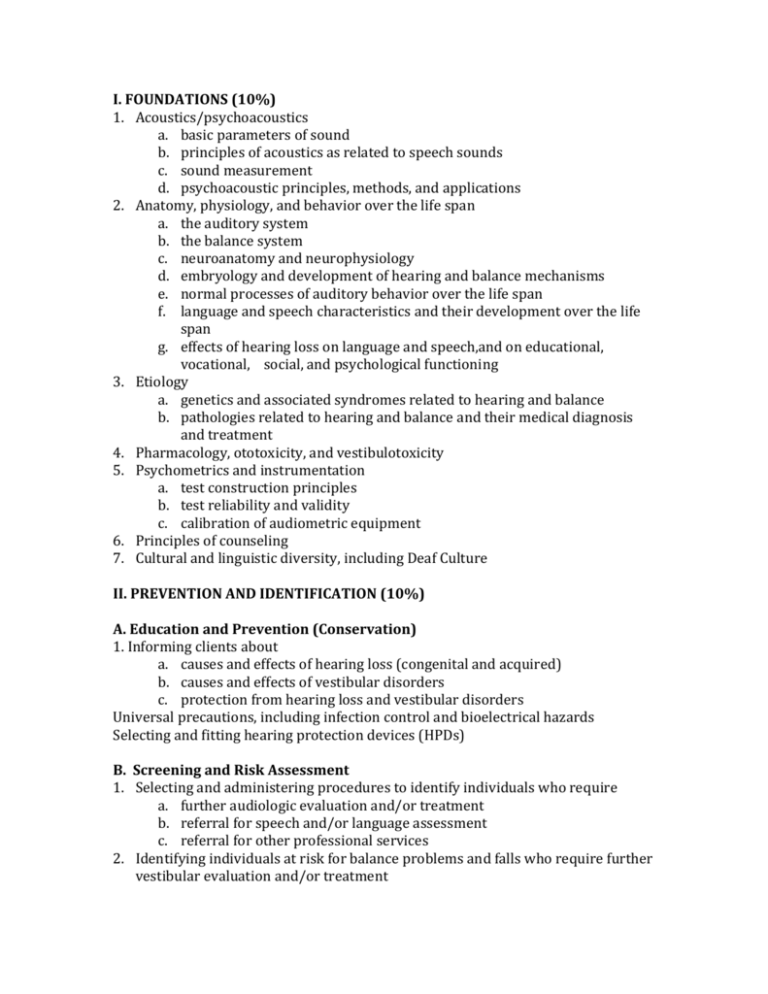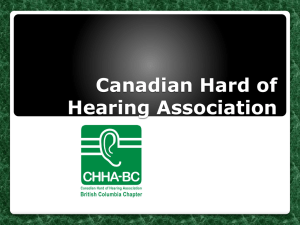Praxis Topics Outline
advertisement

I. FOUNDATIONS (10%) 1. Acoustics/psychoacoustics a. basic parameters of sound b. principles of acoustics as related to speech sounds c. sound measurement d. psychoacoustic principles, methods, and applications 2. Anatomy, physiology, and behavior over the life span a. the auditory system b. the balance system c. neuroanatomy and neurophysiology d. embryology and development of hearing and balance mechanisms e. normal processes of auditory behavior over the life span f. language and speech characteristics and their development over the life span g. effects of hearing loss on language and speech,and on educational, vocational, social, and psychological functioning 3. Etiology a. genetics and associated syndromes related to hearing and balance b. pathologies related to hearing and balance and their medical diagnosis and treatment 4. Pharmacology, ototoxicity, and vestibulotoxicity 5. Psychometrics and instrumentation a. test construction principles b. test reliability and validity c. calibration of audiometric equipment 6. Principles of counseling 7. Cultural and linguistic diversity, including Deaf Culture II. PREVENTION AND IDENTIFICATION (10%) A. Education and Prevention (Conservation) 1. Informing clients about a. causes and effects of hearing loss (congenital and acquired) b. causes and effects of vestibular disorders c. protection from hearing loss and vestibular disorders Universal precautions, including infection control and bioelectrical hazards Selecting and fitting hearing protection devices (HPDs) B. Screening and Risk Assessment 1. Selecting and administering procedures to identify individuals who require a. further audiologic evaluation and/or treatment b. referral for speech and/or language assessment c. referral for other professional services 2. Identifying individuals at risk for balance problems and falls who require further vestibular evaluation and/or treatment 3. Newborn hearing screening programs (early hearing detection and intervention [EHDI]) 4. Selecting, administering, and interpreting self- report measures of hearing problems III. ASSESSMENT (40%) A. Assessment Planning 1. Gathering and evaluating client information (case histories and information from referral sources) to facilitate assessment planning and identify potential etiologic factors 2. Verifying proper functioning of assessment equipment 3. Selecting and modifying procedures based on client factors; e.g., age, developmental level, functional status, behavior, cultural and linguistic diversity, physical, sensory, and cognitive abilities B. Audiologic Evaluation – Behavioral Administering and interpreting 1. Pure-tone air and bone conduction testing 2. Speech audiometry 3. Tests for functional hearing loss 4. Tests for children above 6 months developmental age; e.g., visual reinforcement audiometry and conditioned-play audiometry C. Audiologic Evaluation – Physiologic Administering and interpreting 1. Immittance testing a. tympanometry b. acoustic reflex thresholds c. reflex decay 2. Otoacoustic emission (OAE) testing 3. Auditory evoked potentials a. Auditory brainstem response (ABR) testing i. threshold testing with clicks threshold ii. testing with tone bursts iii. ABR bone conduction threshold testing iv. ABR for neurodiagnostic evaluation 4. Auditory steady state response (ASSR) D. Other Assessments and Evaluations Administering and interpreting 1. Otoscopy: performing otoscopy and ensuring appropriate follow-up, including diagnostic evaluations, intervention, and referrals 2. Self-report measures of hearing problems and their impact on daily living 3. Balance system assessment; e.g., a. videonystagmography (VNG) b. electronystagmography (ENG) c. rotational tests 4. Assessment of communication function; e.g., a. speech in noise testing b. spatial testing c. self-report measures 5. Assessment of tinnitus; e.g., a. pitch matching b. loudness matching c. self-report measures 6. Evaluating (central) auditory processes; e.g., a. gap detection b. dichotic digits c. filtered speech E. Integrating Assessment Results 1. Integrating assessments (behavioral, physiologic, neurodiagnostic, and other evaluations) a. to establish type and severity of hearing loss b. to support recommendations for further evaluation and/or referral 2. Integrating balance function tests (e.g., VNG) with other results to evaluate balance function F. Documentation and Communication 1. Documenting the procedures and results of evaluations 2. Generating recommendations based on evaluations, including referrals, as appropriate, to other audiologists and related professionals 3. Communicating results and recommendations to relevant individuals (e.g., clients, caregivers, physicians, agencies) to coordinate a plan of action 4. Interacting effectively with clients, families, other appropriate individuals, and professionals including working with interpreters (ASL and other languages, sign systems) to effectively communicate with clients IV. INTERVENTION (30%) A. Treatment Planning 1. Evaluating client information to facilitate treatment planning: a. information from referral sources b. case histories Not too long or general. No redundant Elaborate 2. Selecting and modifying treatment procedures based on client factors; e.g., age, developmental level, functional status, behavior, cultural and linguistic diversity, physical, sensory, and cognitive abilities 3. Integrating results of assessments and other evaluations to support recommendations for treatment and/or referral B. Device Selection 1. Evaluating client’s perceived hearing handicap and expectations related to hearing devices 2. Determining candidacy for and selecting: a. hearing aids b. other assistive listening and alerting devices c. cochlear implant(s) d. other implantable devices (e.g., bone- anchored hearing aids) 3. Determining candidacy for and selecting: a. hearing assistive technology system (HATS) for adults; e.g., personal and group amplification systems, assistive listening, and alerting devices b. hearing assistive technology system (HATS) for children C. Hearing Aids 1. Evaluating, for the purpose of hearing aid selection a. speech recognition in noise b. loudness discomfort D. Programming hearing aids 1. Hearing aid coupling; e.g., ear mold modifications, sound bore length, materials 2. Selecting features and processing strategies based on client communication needs; e.g., a. type of amplitude processing b. feedback suppression c. direct audio input E. 1. 2. 3. Cochlear Implants Programming cochlear implants Evaluating implant effectiveness and making appropriate modifications Selecting processing and programming strategies based on client communication needs F. Device Verification and Validation 1. Verifying proper functioning of hearing aids and other assistive devices 2. Conducting quality control measures (e.g., electroacoustic measures, featurespecific probe microphone measures) on hearing technology 3. Probe microphone verification for children; e.g., real ear to coupler difference (RECD) aided thresholds 4. Probe microphone verification for adults; e.g., a. real ear insertion gain (REIG) b. real ear aided response (REAR) c. real ear saturation response (RESR) 5. Evaluating hearing technology effectiveness; e.g., outcome measures, aided speech recognition 6. Repairing and modifying hearing technology devices, when appropriate G. Audiologic (Re)habilitation/lntervention 1. Evaluating and modifying audiologic (re)habilitation, including therapy schedule, discharge criteria, frequency, duration, and type of service 2. Teaching communication strategies to clients and their significant others; e.g., a. speech reading b. conversational repair strategies 3. Facilitating communication development and/ or auditory learning (listening, speech, expressive, and receptive language) 4. Providing support for school-age children; e.g., a. counseling b. addressing the acoustic environment c. consulting with educational personnel d. providing direct therapy H. Tinnitus Management 1. Counseling and sound management intervention (e.g., environmental sound sources, ear level sound generators) and follow-up I. Vestibular Rehabilitation 1. Treatment for benign paroxysmal positional vertigo (BPPV) J. Counseling 1. Counseling related to device use and safety 2. Counseling children’s caregivers about hearing loss, communication development, and modes of communication 3. Providing individual, family, and group counseling related to hearing loss and subsequent communication and areas of psychosocial, behavioral, vocational, and educational adjustment 4. Making referrals, as appropriate, to other audiologists and related professionals K. Documentation and Communication 1. Documentation of intervention processes and results 2. Generating recommendations resulting from intervention processes 3. Communication of recommendations to relevant individuals (e.g., clients, caregivers, physicians, agencies) to coordinate a plan of action 4. Interacting effectively with clients, families, other appropriate individuals, and professionals including working with interpreters (ASL and other languages, sign systems) to effectively communicate with clients about treatment V. PROFESSIONAL ISSUES (10%) A. Professional Practice 1. Different service delivery models in health care and school-based settings 2. Management and business practices; e.g., a. coding and reimbursement b. case management 3. Effective and appropriate communication of results, recommendations, and intervention status a. selecting the means of communication; e.g., formal reports, notes, emails, phone calls b. using language appropriate for the recipient c. maintaining client/patient privacy 4. Equipment calibration and maintenance to standards and manufacturer’s specifications B. Legal and Ethical Practice and Advocacy 1. Standards for professional conduct 2. Protection of clients’/patients’ rights 3. Legislative and regulatory mandates 4. Advocacy for appropriate services a. underserved populations b. inclusion of services in individualized education programs (IEPs) c. insurance appeals C. Evidence-Based Practice 1. Application of research findings to maintain currency in care 2. Research principles and practices; e.g., experimental design, statistical methods, and application to clinical populations








